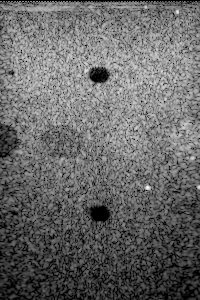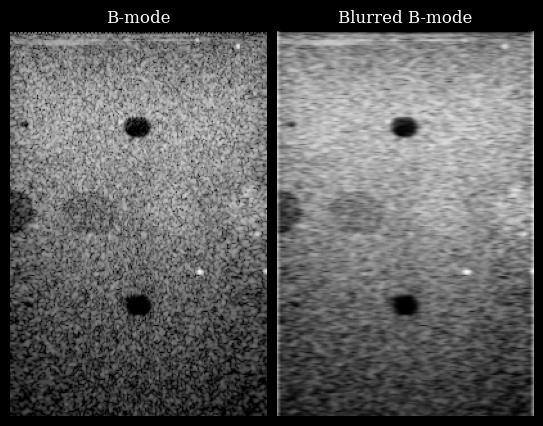Custom PyTorch model in a zea.Pipeline¶
zea.Pipeline using a Lambda operation.[1]:
%%capture
%pip install zea
[2]:
import os
os.environ["KERAS_BACKEND"] = "torch"
[3]:
import torch
import torch.nn as nn
import numpy as np
import keras
from IPython.display import display
import zea
from zea import load_file, init_device
from zea.visualize import set_mpl_style
from zea.ops import (
Pipeline,
PatchedGrid,
EnvelopeDetect,
Normalize,
LogCompress,
TOFCorrection,
DelayAndSum,
Lambda,
)
zea: Using backend 'torch'
WARNING: All log messages before absl::InitializeLog() is called are written to STDERR
E0000 00:00:1753272127.617844 1258532 cuda_dnn.cc:8579] Unable to register cuDNN factory: Attempting to register factory for plugin cuDNN when one has already been registered
E0000 00:00:1753272127.623964 1258532 cuda_blas.cc:1407] Unable to register cuBLAS factory: Attempting to register factory for plugin cuBLAS when one has already been registered
W0000 00:00:1753272127.639240 1258532 computation_placer.cc:177] computation placer already registered. Please check linkage and avoid linking the same target more than once.
W0000 00:00:1753272127.639257 1258532 computation_placer.cc:177] computation placer already registered. Please check linkage and avoid linking the same target more than once.
W0000 00:00:1753272127.639259 1258532 computation_placer.cc:177] computation placer already registered. Please check linkage and avoid linking the same target more than once.
W0000 00:00:1753272127.639261 1258532 computation_placer.cc:177] computation placer already registered. Please check linkage and avoid linking the same target more than once.
Let’s set the parameters for the beamforming grid.
[4]:
grid_size_x = 200
grid_size_z = 300
[5]:
device = init_device(verbose=False)
set_mpl_style()
Load a Frame from the PICMUS Dataset¶
We use the zea loader to load a single frame of raw RF data from the PICMUS dataset, along with scan and probe parameters.
[6]:
# Load a single frame of raw RF data from PICMUS
path = "hf://zeahub/picmus/database/experiments/contrast_speckle/contrast_speckle_expe_dataset_iq/contrast_speckle_expe_dataset_iq.hdf5"
data, scan, probe = load_file(
path=path,
indices=[0],
data_type="raw_data",
)
zlims = (0, 0.06)
xlims = (-0.019, 0.019)
dynamic_range = (-50, 0)
scan.n_ch = data.shape[-1] # iq data
scan.zlims = zlims
scan.xlims = xlims
scan.grid_size_x = grid_size_x
scan.grid_size_z = grid_size_z
Build a zea Pipeline for Beamforming and Image Formation¶
Let’s build an example ultrasound image formation pipeline. We use a PatchedGrid pipeline for memory-efficient beamforming, followed by envelope detection, normalization, and log compression. Currently jit is not supported for backend set to “torch”. If you really want to use jit (understandably so), you are best off using either “jax” or “tensorflow” as the backend.
[7]:
pipeline = Pipeline(
operations=[
PatchedGrid(
operations=[TOFCorrection(), DelayAndSum()],
num_patches=100,
jit_options=None,
),
EnvelopeDetect(),
Normalize(),
LogCompress(),
],
with_batch_dim=True,
jit_options=None,
)
We prepare the parameters for the pipeline and run it to obtain a B-mode image.
[8]:
parameters = pipeline.prepare_parameters(probe, scan, dynamic_range=dynamic_range)
parameters["demodulation_frequency"] = parameters["sampling_frequency"]
inputs = {pipeline.key: keras.ops.convert_to_tensor(data)}
outputs = pipeline(**inputs, **parameters)
bmode = outputs[pipeline.output_key]
bmode_img = zea.display.to_8bit(bmode[0], dynamic_range=dynamic_range)
display(bmode_img)

Embedding a custom PyTorch model¶
We define a simple torch model that applies a Gaussian blur using a convolutional layer with fixed weights.
[9]:
class TorchGaussianBlur(nn.Module):
def __init__(self, kernel_size=7, sigma=2.0):
super().__init__()
self.kernel_size = kernel_size
self.sigma = sigma
self.padding = kernel_size // 2
# Create Gaussian kernel
ax = np.arange(-self.padding, self.padding + 1)
xx, yy = np.meshgrid(ax, ax)
kernel = np.exp(-(xx**2 + yy**2) / (2 * sigma**2))
kernel = kernel / np.sum(kernel)
kernel = kernel.astype(np.float32)
kernel = kernel[None, None, :, :] # shape (1, 1, k, k)
self.register_buffer("weight", torch.from_numpy(kernel))
def forward(self, x):
C = x.shape[1]
weight = self.weight.repeat(C, 1, 1, 1)
return torch.nn.functional.conv2d(x, weight, padding=self.padding, groups=C)
To embed this model in the zea pipeline, we use a Lambda operation that applies the model to the B-mode image. We first need to wrap the model call in a simple function that takes the image as input and returns the processed image.
[10]:
torch_blur_model = TorchGaussianBlur(kernel_size=7, sigma=2.0)
torch_blur_model.eval()
torch_blur_model.to(device)
def torch_blur_inference(image):
"""Simple example inference function for the torch model."""
image = image.to(torch_blur_model.weight.device)
with torch.no_grad():
image = torch.unsqueeze(image, axis=-1)
out = torch_blur_model(image)
out = torch.squeeze(out, axis=-1)
return out
Add a Lambda Operation to an existing Pipeline¶
We add a Lambda operation to the pipeline to run the torch blurring model on the B-mode image.
[11]:
blurring_pipeline = Pipeline(
operations=[
pipeline,
Lambda(func=torch_blur_inference, key=pipeline.output_key, output_key="blurred"),
],
with_batch_dim=True,
jit_options=None,
)
Run the pipeline and visualize the blurred image.
[12]:
result = blurring_pipeline(**inputs, **parameters)
blurred = result["blurred"]
blurred = zea.display.to_8bit(
blurred[0],
dynamic_range=dynamic_range,
pillow=False,
)
bmode_img = zea.display.to_8bit(
bmode[0],
dynamic_range=dynamic_range,
pillow=False,
)
fig, _ = zea.visualize.plot_image_grid(
[bmode_img, blurred],
titles=["B-mode", "Blurred B-mode"],
cmap="gray",
figsize=(10, 5),
)

